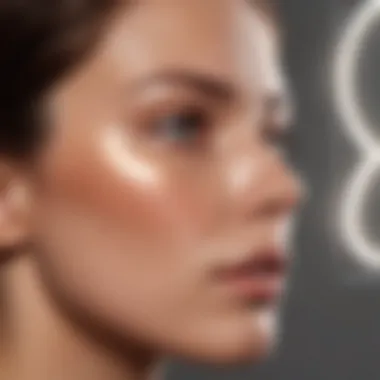Exploring the Efficacy of LED Light Therapy for Skin Care


Intro
The skin care industry continues to evolve, with new technologies emerging to address various skin concerns. Among these innovations, LED light therapy stands out for its scientifically-backed efficacy. This therapy utilizes light-emitting diodes to penetrate the skin at different depths, targeting specific conditions such as acne, wrinkles, and hyperpigmentation. It has gained popularity due to its non-invasive nature and the growing demand for at-home skin care solutions.
As people become more aware of the importance of skin health, understanding the role of LED therapy is essential. This article will discuss the mechanisms behind LED therapy, the types of light used, and the benefits observed in various skin types. Moreover, we will explore safety considerations, the differences between professional treatments and at-home devices, and the ongoing research that supports this innovative approach.
By the end of this article, readers will have a solid grasp of how LED light therapy can be integrated into their skin care routines, enhancing their efforts towards healthier skin.
Prelims to LED Light Therapy
LED light therapy represents a significant advancement in skin care technology. This innovative treatment has garnered attention in both professional settings and at-home skin care routines. Its popularity stems from a variety of factors, including the non-invasive nature of the treatment and the wide range of skin concerns it addresses. Understanding LED light therapy is crucial for those seeking effective skin care options, as it offers potential benefits without the harsh side effects often associated with more invasive procedures.
Definition of LED Light Therapy
LED light therapy utilizes specific wavelengths of light to treat various skin conditions. LED, which stands for Light Emitting Diode, emits light energy that penetrates the skin at different depths, depending on the color and wavelength. This process encourages cellular activity, which promotes healing and rejuvenation. Common colors used in therapy include red, blue, yellow, and green, each serving unique purposes, such as reducing inflammation, fighting acne, and enhancing collagen production.
Historical Context
The origins of LED light therapy can be traced back to NASA, which first explored the use of light-emitting diodes for wound healing in the 1990s. Initial research revealed that certain wavelengths could enhance cellular functions and stimulate tissue repair. Following these discoveries, the technology became more mainstream in dermatology and cosmetic treatments. Today, LED light therapy is a sought-after procedure by dermatologists and estheticians, as well as available in various at-home devices that allow users to incorporate this technology into their regular skin care routines.
"Understanding the evolution of LED light therapy allows us to appreciate its current applications and potential future developments."
The growing body of research supporting its efficacy continues to influence its integration into personal skin care regimens. As consumers become more informed about skin health options, the significance of LED light therapy in the realm of skin care is increasingly evident.
Mechanisms of Action
Understanding the mechanisms of LED light therapy is crucial for grasping its efficacy in skin care. This section elucidates how different wavelengths of light interact with skin cells and initiate various cellular processes. Knowing these mechanisms aids in appreciating why LED therapy can provide distinct benefits for different skin concerns. The interplay between light and skin cells lays the groundwork for effective treatments, making this topic essential for anyone considering LED therapy as a viable skin care option.
How LED Lights Interact with Skin Cells
LED lights emit specific wavelengths that penetrate the skin, reaching various layers where they perform distinct functions. Different colors of light are known to interact with skin cells in unique ways. For example, red light penetrates deep into the dermis and stimulates collagen production. On the other hand, blue light primarily targets the upper layers of skin, effectively neutralizing acne-causing bacteria.
The process begins when light photons strike the skin's surface and are absorbed by chromophores within the cells. Chromophores are molecules that absorb light at specific wavelengths, triggering a series of biochemical reactions. This absorption leads to a phenomenon known as photobiomodulation, where the energy from the light stimulates cellular activity, ultimately influencing various skin functions.
Cellular Reactions and Repair Processes
Once LED light is absorbed by skin cells, it sets off cellular reactions that promote healing and rejuvenation. The most notable effect is enhanced ATP (adenosine triphosphate) production. ATP is the energy currency of the cell, and its increased availability accelerates cellular processes crucial for skin repair, such as rejuvenation and regeneration.
Moreover, LED therapy induces the release of growth factors and other signaling molecules. These substances play a significant role in collagen synthesis, wound healing, and reducing inflammation. For example, increased collagen synthesis helps in diminishing the appearance of fine lines and wrinkles, while the anti-inflammatory effects are beneficial for conditions like rosacea and sensitive skin.
In summary, understanding how LED lights interact with skin cells and the subsequent cellular reactions provides insight into the therapeutic potential of this innovative skin care technology. The mechanisms involved not only enhance the skin's natural processes but also pave the way for targeted treatments against a variety of skin issues. By embracing these scientific principles, users can better appreciate the effectiveness of LED light therapy in skincare routines.
Types of LED Light and Their Functions
The discussion on types of LED light is crucial in understanding how these therapies work and their varied applications in skin care. Each type of LED light has a specific wavelength, which determines its function and efficacy in treating various skin conditions. Therefore, knowing the different types helps consumers make informed decisions about their skincare routines and which treatments to prioritize.
Red Light Therapy
Red light therapy is one of the most well-known forms of LED therapy. It typically operates within the wavelength range of 620 to 750 nanometers. This type of light penetrates the skin's layers effectively, reaching the dermis where it can stimulate collagen production. Collagen is a crucial protein that maintains skin elasticity and firmness.
Benefits of Red Light Therapy:


- Anti-Aging – Increases collagen, reducing wrinkles and fine lines.
- Wound Healing – Promotes faster recovery from injuries by enhancing cellular repair.
- Inflammation Reduction – Useful in managing inflammation-related skin issues.
Due to these benefits, red light therapy is becoming popular in both professional treatments and at-home devices. Users often report visible improvements in skin texture and tone after consistent use.
Blue Light Therapy
Blue light therapy focuses on wavelengths between 405 and 495 nanometers. This specific light targets the bacteria responsible for acne, specifically Propionibacterium acnes. It acts by killing these bacteria, thus reducing the occurrence and severity of acne breakouts.
Benefits of Blue Light Therapy:
- Acne Treatment – Effective in reducing spots and breakouts.
- Oil Production Control – Can help by minimizing excessive oiliness in the skin, which contributes to acne.
Blue light therapy has gained traction primarily among younger demographics dealing with acne. The ease of access to at-home blue light devices makes it a preferred choice for routine skincare regimens.
Yellow and Green Light Therapy
Yellow and green light therapies are less common but serve vital roles in specialized skin treatments. Yellow light typically ranges from 570 to 590 nanometers, while green light ranges from 520 to 570 nanometers.
Benefits of Yellow Light Therapy:
- Reduces Redness – Helps in diminishing redness associated with skin irritation.
- Boosts Radiance – Aims to improve skin texture, leaving it looking youthful.
Benefits of Green Light Therapy:
- Hyperpigmentation Treatment – Useful in treating dark spots and ensuring a more even skin tone.
- Calming Effects – Known for its soothing properties, helping to calm irritated skin.
Skin Conditions Treated by LED Light Therapy
LED light therapy has garnered attention in the skincare industry due to its potential effectiveness across various skin conditions. Understanding how this technology works can significantly inform users about suitable options for their unique dermatological needs. This section explores notable skin issues that LED therapy specifically targets, highlighting its advantages and challenges.
Acne Treatment
Acne is a prevailing problem affecting individuals across many age groups. Blue light therapy, one of the key components of LED treatments, plays a vital role in managing acne. The blue wavelengths penetrate the skin and target Propionibacterium acnes, the bacteria responsible for acne formation. By reducing bacterial populations, blue light therapy can help diminish existing breakouts and prevent future flare-ups. Regular use can lead to clearer skin, which improves not just skin appearance but also boosts self-esteem.
Wrinkles and Fine Lines
As we age, wrinkles and fine lines naturally appear due to decreased collagen production. Red light therapy, characterized by longer wavelengths, stimulates collagen synthesis in the skin. This specific application can enhance skin's texture and elasticity, resulting in visibly smoother and firmer skin. Studies suggest that consistent use of LED therapy targeting this condition can yield convincing results over time, making it an appealing choice for those seeking non-invasive alternatives to more drastic cosmetic procedures.
Hyperpigmentation
Hyperpigmentation, marked by dark patches on the skin, poses a common aesthetic challenge. Various light wavelengths, especially green light, have shown promise in reducing uneven skin tone. Green light works by targeting melanin-producing cells, potentially leading to a more balanced complexion. Regular treatments can prove beneficial for users looking to lighten dark spots while maintaining overall skin health. It’s important to combine LED therapy with other treatments, like topical antioxidants, for optimal results.
Sensitive Skin and Rosacea
Many individuals suffer from sensitive skin or conditions like rosacea, which often leaves them feeling limited in their skincare choices. LED light therapy offers a gentle alternative. Red and yellow lights can soothe inflammation and redness, helping to calm irritated skin. This therapeutic approach may reduce flare-ups, allowing users to feel at ease within their skin. Moreover, consistency in treatment can enhance tolerance and lead to improved skin resilience over time.
LED light therapy presents a compelling innovation in the fight against various skin conditions, providing insights on how technology can enhance skincare routines.
In summary, LED light therapy can effectively target specific skin conditions, offering a multi-faceted approach to skincare. The array of treatments available provides options for a diverse audience, including those facing challenges like acne, aging, hyperpigmentation, and sensitivity. Engaging with these therapies can enrich the overall skincare regimen, resulting in not just aesthetic benefits but also an enhanced quality of life.
Effectiveness of At-Home LED Devices


At-home LED devices offer an appealing alternative to professional treatments, making advanced skincare accessible to a wider audience. Their effectiveness is a critical consideration for users interested in enhancing their skincare routines. Understanding what these devices can achieve—and their limitations—is essential for optimal results.
Comparative Analysis with Professional Treatments
Comparing at-home devices with professional LED treatments reveals significant insights. Professional devices, typically found in dermatology clinics and salons, use higher intensity and more specific wavelength light, which can yield quicker and more noticeable results.
Benefits of Professional Treatments:
- Stronger Light Output: Professionals can utilize devices that emit higher energy levels. This often leads to accelerated healing and enhancement.
- Customized Programs: Treatments are usually personalized to address individual skin concerns, which can maximize their effectiveness.
- Expert Guidance: Professionals assess skin conditions and provide advice on the best course of treatment, ensuring clients achieve optimal outcomes.
While at-home devices may lack the power of their professional counterparts, they still deliver substantial benefits. Regular use of these devices can lead to improved skin texture, diminished fine lines, and better overall complexion. Moreover, at-home devices allow for convenience and flexibility with a less financial commitment compared to professional sessions.
Consumer Devices: What To Look For
When selecting at-home LED devices, several essential factors should guide the purchasing decision. Awareness of these elements helps consumers invest wisely and achieve desired results.
Key Considerations for At-Home LED Devices:
- Wavelength Variety: Look for devices that offer multiple light wavelengths. Different colors like red, blue, and green serve specific skin issues, making versatility an important feature.
- Ease of Use: Choose devices that are user-friendly. Complicated operating procedures can discourage regular use, which is crucial for efficacy.
- Safety Features: Ensure that the device is equipped with safety certifications. This reduces the risk of skin damage and adverse effects.
- User Reviews: Consumer feedback can provide insights into the reliability and effectiveness of a product. Checking reviews on platforms like Reddit can be insightful and guide decisions.
- Return Policy: A good return policy protects consumers, offering the option to test the device without commitment.
Safety and Side Effects
When discussing LED light therapy for skin care, it is essential to address the topic of safety and potential side effects. This aspect is paramount because while LED therapy can offer numerous benefits for the skin, an understanding of safety practices can greatly enhance the user experience and results. Awareness of any side effects ensures that users make informed decisions and approach treatments with caution.
Common Concerns and Misconceptions
Many individuals express concerns about the safety of LED light therapy. It is normal to fear that the utilization of bright lights on the skin may lead to adverse effects. However, extensive research indicates that when used correctly, LED therapy is generally safe for all skin types.
Some common misconceptions include:
- LED lights can cause skin damage. This is inaccurate. LED therapy is non-invasive and does not emit UV radiation, meaning it doesn’t have the harmful effects associated with sunlight exposure.
- Only professionals can safely use LED devices. Many consumer-level devices are designed with safety features, making them suitable for home use. However, proper usage according to the manufacturer’s guidelines is crucial.
- LED therapy will cause immediate results. While users may see some effects after the first session, consistent use over a period is typically necessary for noticeable improvements.
Additionally, there are some concerns around the potential for eye damage. Looking directly at the light can cause temporary discomfort. Users are advised to wear protective eyewear during treatments to mitigate this risk.
"The safety profile of LED light therapy highlights its efficacy without the invasive risks typically associated with other skin treatment modalities."
Precautions and Recommendations
To maximize the benefits of LED light therapy while minimizing risks, consider the following precautions:
- Choose FDA Approved Devices: Make sure the device you’re using is clear from the FDA for safety and efficacy. This ensures a standard of quality and care for your skin.
- Perform a Patch Test: Before using a new device on large skin areas, try it on a small section first. This action can help identify any adverse reactions that might occur.
- Follow the Duration Guidelines: Each manufacturer will specify how long to use their device. Adhering to these recommendations is key to avoiding potential side effects.
- Avoid Other Treatments Directly Before Use: Refrain from using abrasive scrubs, chemical peels, or other intense treatments right before using LED light therapy. Your skin should be in a calm state to avoid irritation.
- Consult Professionals When Necessary: If you have pre-existing skin conditions like eczema or rosacea, consult a dermatologist before engaging in LED therapies. They can guide you on the best practices tailored to your skin type.
Incorporating these safety measures and recommendations into your skincare routine will not only enhance effectiveness but also ensure that your experience with LED light therapy remains beneficial and safe.
Current Research in LED Light Therapy
LED light therapy is a rapidly evolving field, increasingly important for understanding advanced skincare. Continuous research highlights its potential and adaptability for various skin conditions. It challenges established skincare treatments and presents a promising alternative. This section uncovers critical updates in ongoing studies and sets the stage for future inquiries in the area of LED technology for skin.
Latest Findings in Clinical Trials
Recent clinical trials have provided significant insights into the efficacy of LED light therapy.


- Enhanced Collagen Production: A study published in the Journal of Cosmetic and Laser Therapy found that participants using red LED light therapy after chemical peels saw a notable boost in collagen synthesis.
- Reduction in Inflammatory Acne: Another research published in the Journal of Dermatological Treatment indicated that blue light therapy led to improvements in acne, with 70% of participants experiencing reduced inflammatory lesions after consistent usage.
- Skin Rejuvenation Outcomes: Various trials presented evidence supporting LED therapy's role in skin rejuvenation. Improvements in skin texture and elasticity were documented, showing the mechanism's direct correlation with stimulating fibroblast activity.
These findings emphasize that LED light therapy is not just a cosmetic treatment. It engages complex biological pathways to support skin healing and rejuvenation.
Future Directions of Research
Looking ahead, several avenues for research in LED light therapy appear promising. The diversity of light wavelengths and their specific effects on skin cells remain underexplored.
- Combination Therapies: Research may explore the effectiveness of combining LED therapy with other skincare treatments. For example, pairing it with topical retinoids could enhance results for anti-aging treatments.
- Customized Treatments: Advances in personalization will likely be a pivotal area. Tailoring LED therapy to cater to individual skin types and conditions can maximize efficacy.
- Long-term Impact Studies: More extensive longitudinal studies are essential to understand the long-term benefits. Detailed follow-ups could ascertain the sustained impact of LED therapy on skin health.
In summary, current research emphasizes the benefits of LED light therapy while calling for further studies to unlock its full potential. As the landscape of skincare evolves, LED therapy stands to play an increasingly crucial role in effective skincare regimens.
"The future of LED therapy in skin care rests on continued research and innovation, ultimately leading to more effective and personalized skincare solutions."
Integrating LED Light Therapy into Skincare Routines
Integrating LED light therapy into skincare routines captures significant interest from those looking to enhance their skin's appearance and health. This section addresses how to incorporate this innovative treatment while maximizing its benefits and addressing the practical aspects of its use alongside existing skincare habits.
The relevance of this integration is multi-faceted. Firstly, LED light therapy can support various skin conditions and improve overall skin quality, making it a complementary addition to many routines. Secondly, understanding the best practices and compatibility with other treatments ensures optimal results. Integrating this therapy not only enhances existing routines but also empowers users to take a proactive approach before resorting to more invasive procedures.
Best Practices for Use
To ensure effective results, adhering to the best practices when using LED light therapy is essential. Here are some guidelines that should be followed:
- Consistent Routine: Regular use is key to achieving the desired effects. Aim for at least two to three sessions per week, depending on skin type and treatment goals.
- Pre-Cleanse Skin: Before starting, cleanse the skin thoroughly to remove any makeup, dirt, or oils. This clean base allows optimal light penetration.
- Choose Appropriate Wavelength: Different wavelengths target specific concerns. For instance, red light is excellent for anti-aging, while blue light is effective for acne treatment. Select the right color for your skin needs.
- Duration of Treatment: Follow the device instructions regarding treatment duration. Typically, sessions can last between 10 to 30 minutes, depending on the device and intended use.
- Hydration Post-Treatment: After therapy, apply a suitable moisturizer or serum to lock in the benefits. Hydrating the skin helps enhance the effects of the therapy.
Engaging in these practices not only promotes skin recovery but also optimizes the overall efficacy of the treatment.
Compatibility with Other Skincare Treatments
Compatibility with other skincare treatments is a critical consideration to ensure users enhance their beauty routine effectively. Here are some points to consider while integrating LED light therapy:
- Layering Treatments: LED therapy can often be used alongside serums containing antioxidants or hyaluronic acid, which bolster hydration and skin repair mechanisms.
- Avoid Irritating Ingredients: Ingredients with strong active agents, such as retinol or acids, should be used with caution. Initially, try using LED therapy on days without these products to avoid irritation.
- Consultation with Professionals: Prior to combining therapies, it is advisable to consult with dermatologists or skincare professionals. They can provide personalized recommendations based on skin type and specific concerns.
By considering product interactions and choosing complementary treatments, users can yield better skin outcomes while enjoying the benefits of LED light therapy.
Integrating LED light therapy in skincare routines represents a proactive approach to skin health, combining technology with daily care practices.
Finale
The conclusion serves as a crucial element in this article about LED light therapy for skin care. It ties together the various insights gathered throughout the sections. Understanding the efficacy of LED light therapy is essential for individuals looking to improve their skin health with scientifically-backed methods.
Summarizing Key Points
LED light therapy has emerged as a noteworthy advancement in the realm of skin care, appealing to a broad demographic. Key points include:
- Diverse Functions: LED therapy encompasses various wavelengths, each targeting specific skin issues such as acne, wrinkles, and hyperpigmentation.
- Mechanisms of Action: The interaction of LED light with skin cells promotes cellular repair and rejuvenation, demonstrating clear benefits for skin health.
- Safety Measures: By acknowledging the importance of safety and potential side effects, users can confidently incorporate LED therapy into their routines.
- Research and Development: Ongoing studies continue to explore new applications and validate the existing benefits of LED light therapy, making it a continually evolving field.
These points collectively highlight the advantages of LED light therapy and its significance in modern skin care practices.
Personal Considerations for Potential Users
When considering LED light therapy, potential users should reflect on a few important factors:
- Skin Type: Different skin types may respond differently to various wavelengths. Assessing one’s own skin condition can guide the choice of treatment.
- Treatment Goals: Individuals should clarify their desired outcomes, such as reducing acne or enhancing skin texture, to tailor their therapy effectively.
- Device Selection: For those opting for at-home devices, crucial factors include the quality, wavelength efficacy, and warranty of the device.
- Consultation with Professionals: Before starting any new skin care regime involving LED therapy, it is wise to discuss with a dermatologist or skincare expert to ensure suitability.
Overall, personal considerations, when aligned with informed choices about LED light therapy, can lead to more effective results in one’s skincare journey.



